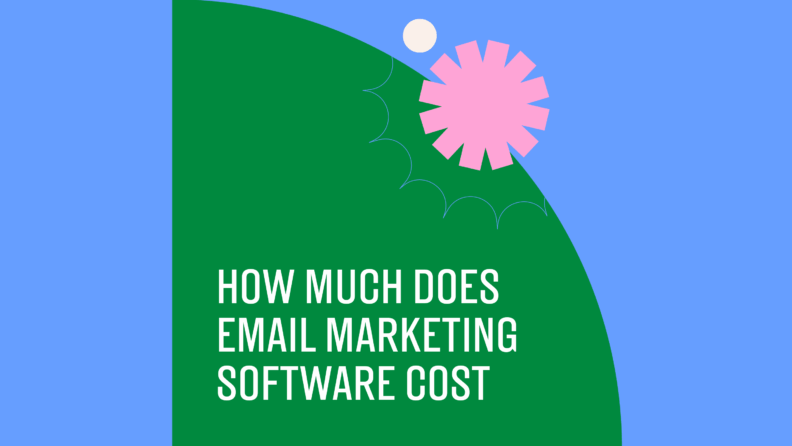Pricing varies based on features, usage, and service level; your team might pay more for advanced analytics or higher email send limits
Upfront cost doesn’t reflect total cost; watch for add-ons like premium support or extra user licenses that can increase expenses
Smart buyers focus on ROI and scalability, not just sticker price; choose a solution that grows with your business and delivers measurable results
Navigating the cost of email marketing software can be tricky. Pricing tiers, feature gating, and scarce public info make it confusing. You're not alone in this.
In this guide, I'll walk you through typical cost ranges, pricing models, and potential hidden fees. Plus, I'll share advice on evaluating ROI. Let's make sure your team gets the best value for its investment.
The CMO’s Email Marketing Software Cost Calculator
What Factors Influence Email Marketing Software Pricing?
Picking the right email marketing software means understanding how factors like contact limits, campaign features, and integration options can affect your costs. Here's a breakdown of what to consider:
| Factor | How It Affects Pricing |
| Contacts/Emails Included | The more contacts or emails you need to send, the higher the cost. Plans might start at $10/month for 500 contacts and can go up significantly as your list grows. |
| Campaign Limits | Some plans limit the number of campaigns you can run. If you need unlimited campaigns, expect to pay an extra $20-$50/month. |
| CRM Integration | Integration with your CRM can streamline workflows but may add $15-$30/month to your costs, depending on the complexity of the integration. |
| Automation Features | Advanced automation features like customer journeys or triggered emails can increase your monthly bill by $25-$75, depending on the sophistication of the tools you require. |
| Reporting and Analytics | Detailed reporting tools are often premium features that can add $10-$40/month, helping you better understand your campaign performance and ROI. |
Email Marketing Software Price Comparison
| Tool | Best For | Trial Info | Price | ||
|---|---|---|---|---|---|
| 1 | Best for audience segmentation tools | Free plan available | From $11.20/month | Website | |
| 2 | Best for automated features | 14-day free trial | From $25/user/month (billed annually) | Website | |
| 3 | Best for agencies and franchises | Free plan available | From $5/5,000 contacts/month | Website | |
| 4 | Best for drag-and-drop email design | 30-day free trial | From $9/user/month | Website | |
| 5 | Best for email and SMS marketing | 30-day free trial | From $59/month | Website | |
| 6 | Best for targeting the customer lifecycle | 14-day free trial | From $20/month | Website | |
| 7 | Best for multichannel marketing campaigns | Free trial + freemium plan available | From $15/month | Website | |
| 8 | Best for advanced integrations | Free plan available | From $45/month (billed annually) | Website | |
| 9 | Best for ecommerce businesses | 14-day free trial | From $39/month | Website | |
| 10 | Best for beginners | 30-day free trial + free plan available | From $13/month | Website |
Understanding Pricing Models
When choosing email marketing software, it's crucial to understand that pricing models differ from the actual cost. Models like tiered subscriptions or pay-as-you-go can offer flexibility but also come with their own set of considerations. Here's a breakdown of common pricing models you might encounter:
| Pricing Model | How It Works | What to Watch For |
| Per user or seat | You pay for each user accessing the software | Costs can add up quickly as your team grows |
| Per usage | Charges are based on the number of emails sent or contacts managed | High usage can lead to unexpected expenses |
| Tiered subscription | Different tiers offer varied features at different price points | Features you need might be locked in higher tiers |
| Custom quote | Pricing is tailored to your specific needs | Lack of transparency can make it hard to compare with other options |
| Pay-as-you-go or annual | Pay for what you use monthly or commit to a yearly plan for a discount | Monthly plans offer flexibility, but annual plans can save money if you're committed long-term |
Typical Pricing by Company Size
Understanding how pricing scales with company size helps you budget more effectively and choose an email marketing solution that fits your needs. Here's what you can expect based on your company size:
| Company Size | Typical Price Range | What’s Usually Included | Common Use Cases & Vendors |
| Small business | $10–$50/month | Basic email campaigns and templates, limited automation | Newsletters, small campaigns; Mailchimp, Constant Contact |
| Mid-size business | $50–$200/month | Advanced automation, analytics, more contacts | Targeted campaigns, segmentation; ActiveCampaign, GetResponse |
| Large business | $200–$500/month | Comprehensive analytics, CRM integration, higher limits | Large-scale campaigns, CRM sync; HubSpot, Sendinblue |
| Enterprise | $500+/month | Custom integrations, dedicated support, unlimited features | Global campaigns, multi-department use; Salesforce Marketing Cloud, Oracle Eloqua |
Hidden & Add-On Costs to Watch For
When you’re deciding on an email marketing software, it's important to look out for hidden costs that can catch you off guard. Some vendors might charge for onboarding, while others could have fees for premium support or advanced integrations. Here's a breakdown of potential hidden costs to consider:
| Hidden/Add-On Cost | Description |
| Onboarding/setup fees | Some vendors, like Salesforce Marketing Cloud, charge hefty setup fees to get you started, which can add hundreds to your initial investment. |
| Training or certifications | Platforms such as HubSpot may offer training sessions or certifications at an additional cost, which might be necessary for your team to fully utilize the software. |
| Premium support | If you need priority support, vendors like Mailchimp offer premium support tiers that can increase your monthly fees. |
| Integrations beyond standard set | Connecting to non-standard CRMs or tools often incurs extra fees, as seen with Sendinblue's custom integration services. |
| Usage overages | Exceeding your email or contact limits can lead to overage charges, a common scenario with Constant Contact's pricing plans. |
| Contract minimums | Some vendors, like Oracle Eloqua, require you to commit to long-term contracts, which can lock you into a pricing structure that might not suit your evolving needs. |
| Compliance or legal updates | Vendors may charge for updates related to compliance changes, such as GDPR, as seen with some enterprise-level solutions. |
Types of Email Marketing Software Pricing: Subscription Plans & Upgrade Triggers
Email marketing software often uses subscription plans with tiered pricing, where different levels offer varying features and capabilities:
- What’s Included in Each Plan: Most vendors like Mailchimp and Constant Contact offer basic features in their entry-level plans, such as email templates and basic analytics. Advanced plans might include automation and segmentation tools.
- Upgrade Triggers: These can include reaching a certain number of contacts or emails sent. For example, HubSpot might require an upgrade once you exceed certain contact limits or need more advanced CRM integrations.
- Annual vs Monthly Discounts: Vendors often provide discounts for annual payments. For instance, ConvertKit offers savings if you pay yearly instead of monthly, which can be beneficial if you're committed long-term.
To avoid overspending, evaluate your current needs and future growth. Choose a plan that fits your team's size and expected usage without unnecessary upgrades.
Maximizing ROI from Your Email Marketing Software Investment
Understanding ROI helps you make informed buying decisions and track the value of your email marketing software after implementation:
Time Saved
Automation and streamlined workflows can significantly reduce the manual effort required, freeing up your team’s bandwidth for more strategic tasks. Consider what manual processes the software will replace and how much time your team could get back. Ask vendors to demonstrate time-saving features in a typical use case to see potential benefits in action. Evaluate if the automation aligns with your existing workflows to ensure it truly saves time.
Error Reduction
By reducing manual handoffs or calculations, email marketing software can prevent costly mistakes. Identify where errors currently happen and how the new system would reduce them. Ask vendors how data is validated or controlled across the platform to minimize errors. Ensure the software offers robust error-checking mechanisms that align with your team's needs.
Compliance Avoidance
Features that support legal, financial, or industry standards help reduce the risk of fines or audits. Investigate what compliance features are built in and if the platform supports your specific industry requirements. Ask vendors for examples of how compliance gaps were avoided in other implementations. Verify that the software adheres to the necessary standards for your business.
Cross-Team Adoption or Consolidation
One tool that replaces many, or is easily adopted by multiple teams, can cut costs and improve alignment. Determine if the software could replace multiple tools and which teams would realistically use it. Ask vendors for rollout stories across functions to gauge ease of adoption. Ensure the software is intuitive and meets the needs of various departments within your organization.
Questions to Ask Vendors During Pricing Demos
Demos are your team’s best opportunity to clarify pricing, dig into what’s included, and avoid surprises. Come prepared with questions to ensure you understand the full scope of costs. Consider drafting an email marketing software RFP to guide these discussions:
- How is your pricing structured, and what are the key differences between tiers?
- What features are included in each pricing tier, and which require an upgrade?
- Are there any usage caps or overages we should be aware of?
- What are the costs for support and onboarding?
- How often is billing done, and what are the renewal terms?
- What integrations are included, and are there limits on connecting to other tools?
- Are there any seasonal or promotional discounts we should know about?
- How do you handle changes in contact or email limits during a billing cycle?
Tips for Negotiating Email Marketing Software Pricing
Pricing is often flexible, and being prepared can lead to better outcomes. By using strong negotiation tactics, your team can secure more favorable pricing and contract terms without losing essential functionality. Here are some tips to help you negotiate effectively:
- Benchmarking Competitors: Research what competitors offer and at what price. Use this information to push for a better deal by showing the vendor you have options.
- Discount Opportunities: Ask about discounts for startups, nonprofits, or long-term commitments. Vendors often have special rates that aren't advertised.
- Pilot Programs or Phased Rollout Pricing: Suggest starting with a pilot program or phased rollout. This can help negotiate lower initial costs and evaluate the software's fit before full deployment.
- Renewal and Lock-In Clauses: Pay attention to renewal terms and lock-in clauses. Negotiate for flexible terms that allow you to reassess your needs without penalties.
- Leveraging Group Buying or Procurement Support: If your organization is part of a larger group or consortium, use that leverage for better pricing. Procurement teams can often negotiate better terms due to volume.
What’s Next:
If you're in the process of researching email marketing software, connect with a SoftwareSelect advisor for free recommendations.
You fill out a form and have a quick chat where they get into the specifics of your needs. Then you'll get a shortlist of software to review. They'll even support you through the entire buying process, including price negotiations.











